Conference on Tobacco, Law and Human Rights: Crossing borders, spaces and substances

By Ellen Henricson
Tobacco is a leading cause of death, illness, and impoverishment. Its health risks, from direct consumption as well as second-hand exposure, are by now indisputable. Of the different available forms of tobacco, cigarette smoking is the most common one. Most smokers start already as children or adolescents and live in low- and middle-income countries. Other tobacco products, such as e-cigarettes, cigars, waterpipe tobacco, and various types of smokeless tobacco, are likewise inherently toxic and highly addictive. International, regional, and domestic laws are crucial for shaping tobacco policies, and there are increasing regulatory efforts on all levels. Still, legal scholarship on tobacco is scarce.
Aiming to fill this gap, Prof. Brigit Toebes, Dr. Katerina Tsampi and Dr. Michelle Bruijn, from the Faculty of Law of the University of Groningen and Global Health Law Groningen, organised, under the auspices of the European Scientific Network on Law and Tobacco and KWF, the International Conference on Tobacco, Law and Human Rights: crossing borders, spaces and substances in Groningen, the Netherlands on 12-13 May 2022. During the conference – which brought together legal practitioners, researchers, medical doctors, and advocates from various parts of the world – three main themes were considered. The first day focused on novel smoke-free policies and national best practices. With reference to lessons learned from the Council of Europe institutions, the role of human rights protection and accountability in tobacco control was highlighted during the second day. Lastly, the discussion moved on to the interplay between regulation of tobacco, cannabis, and alcohol.
Once Birgit Toebes had set the scene and opened the conference with a welcoming speech, Stefana Negri gave the first keynote speech outlining lessons learned from the experience of various countries in creating and implementing smoke-free policies. During the first set of paper presentations, Nienke Boderie, Heike Garritsen, and Tessa van Deelen all shared their work on smoke-free policies. Nienke Boderie presented the results of a systematic review and meta-analysis on public support for smoke-free policies in outdoor areas and (semi-)private spaces globally. The results indicate that public support, which has increased over time, is the highest for indoor private areas, and especially cars with children. There are large differences between (ex-)smokers and non-smokers, but the degree of support is not significantly associated with age, sex, or parental status. Heike Garritsen, in turn, shared the results of a study examining the perception of key stakeholders at Dutch sports clubs with regard to implementing outdoor smoke-free policies. The main obstacles were impaired social functions of the clubs, problems with compliance and enforcement, conflict with smokers’ interests, and low priority in club management. Discussing a spatial analysis of socioeconomic neighbourhood differences in proximity to tobacco outlets, Tessa van Deelen noted that in three smaller cities, tobacco outlets were placed closer to neighbourhoods with lower socioeconomic status, but no correlation was found in Amsterdam. Point-of-sale tobacco control policies may reduce differences in smoking between socioeconomic groups within cities.
In her keynote speech, Wanda de Kanter brought up the possibility of using litigation as a tool for ending the tobacco industry once and for all, with examples of four Dutch criminal lawsuits brought by medical doctors. This was followed by Jasper Been’s keynote on the importance of smoke-free environments for ensuring a smoke-free generation. The day was concluded with two interactive sessions, the first dealing with the results of an interdisciplinary research collaboration on novel smoke-free policies protecting children as part of the tobacco endgame, and the second on translation of the national smoke-free generation policy to regional and municipal levels.
The first part of day two focused on human rights protection and accountability in tobacco control, as seen in the European institutions. The day was opened by Katerina Tsampi, who introduced the theme. Aoife Nolan then discussed the role of the European Social Charter in connecting the right to protection of health and tobacco control. Picking up the same thought, Katerina Tsampi illustrated how the European Court of Human Rights has dealt with the topic. Although its expected role is marginal, she found that the case-law on tobacco control is surprisingly rich and remarked that the European Convention on Human Rights system has significant potential in the fight against tobacco. Drawing a parallel, Giulia Bosi showed that a similar potential is inherent in the collective complaints procedure of the European Committee of Social Rights, which oversees the implementation of the European Social Charter that was discussed earlier by Aoife Nolan. This system has the potential to, on the basis of Article 11 and through collective complaints, directly address violations of the right to health caused by inadequate tobacco policies. Even though the mechanism has never been used in this way, Giulia Bosi argued that it presents a valuable tool to put pressure on States to do better, especially as there is no requirement of exhaustion of domestic remedies.
Phon van den Biesen continued the theme with a focus on the Dutch experience and with reference to the practical utility in litigation of the anti-lobbying Article 5.3 of the Framework Convention on Tobacco Control. In his experience, protection of the rights of the child and the link to international human rights are crucial since those provide for added legal weight whenever the interests of parties need to be balanced by the judiciary or the legislative. The general idea is that human rights interests should outweigh the commercial interests of the tobacco industry.
Presentations by Kelsey Romeo-Stuppy and Raouf Alebshehy continued the question of what role human rights and balancing might play in ensuring better tobacco control. Kelsey Romeo-Stuppy called for extending the human-rights based approach to tobacco control, as adopted in the United States, to Europe. She argued that change can be accelerated by reference to both international and national human rights advocacy. Raouf Alebshehy picked up the thread of Article 5.3 of the Framework Convention on Tobacco Control and emphasised the importance of not allowing the tobacco industry to influence tobacco policies. However, a study he took part in found that diplomatic representatives of States nevertheless repeatedly have lobbied for the tobacco industry, attended meetings with the industry, and at one instance even opened a cigarette factory. This shows the need to enforce Article 5.3 also for diplomats who are working abroad. The theme was concluded with an interactive panel discussion led by Dominique Mollet and Ellen Henricson, who gave an overview of their mappings of what the European Court of Human Rights and the European Committee of Social Rights respectively have said on tobacco control. In the former, the most striking examples are prison cases, while the latter focuses on protection of children and education.
The last part of the conference, covering the interplay between regulation of tobacco, cannabis, food, and alcohol, was introduced by Michelle Bruijn, who emphasised the importance of finding the sweet spot between insufficient and excessive levels of regulation. Josiane Rioux Collin then discussed the relatively new and underresearched e-cigarettes. Due to the grey areas created by lack of scientific data and research, regulation is rather complex. Since the product is particularly attractive to young people and might act as a gateway, the precautionary principle was central in adopting legislation in Quebec. Continuing on the importance of the precautionary principle and focusing on child health, Adam Bertscher took South African alcohol regulation as a case study in how human rights considerations can aid in ensuring protection. He discussed the balance against advertising rights, including in particular the freedom of expression. Limitation of advertising is justifiable when done with the aim of protecting public health, children’s right to health, and the right to be free from all forms of violence. As such, the human rights arguments used by industries generally do not hold when subjected to a thorough human rights analysis.
Pointing to the link between cannabis, alcohol, tobacco, and unhealthy foodstuffs, Margherita Melillo and Isabel Barbosa called for a coherent regulatory approach to unhealthy commodities. They showed how different products, which all are unhealthy and potentially addictive, have been met with radically different policies. They agreed with Michelle Bruijn that while unregulated markets are ineffective in addressing public health concerns, criminalising unhealthy commodities is too. Hence, the current patchwork of fragmented regulation should in their view be developed into a coherent middle-ground framework, centred around the protection of public health. Florence Berteletti gave the final keynote, emphasising how crucial it is to keep the tobacco industry from having any influence on regulation, the importance of advocates speaking with one voice despite any internal disagreements, and that understanding the function of policy processes can help.
The conference was closed by Brigit Toebes, who summarised the take-aways. A few main points were present throughout the rich discussions of the conference. Firstly, the clear consensus was that protection of children is a promising starting point for advocacy. Further, the industry must be kept out of the regulatory process, to enable any progress at all. Meanwhile, regional and international institutions have the potential to address inadequate tobacco policies, for instance by relying on human rights standards. Lastly, to achieve a coherent regulatory framework for effective tobacco control of the kind that is desperately needed, interdisciplinary collaboration is key.
Bio

Ellen Henricson follows the programmes LLM International Human Rights Law and Research Master in Theoretical Philosophy at the University of Groningen.